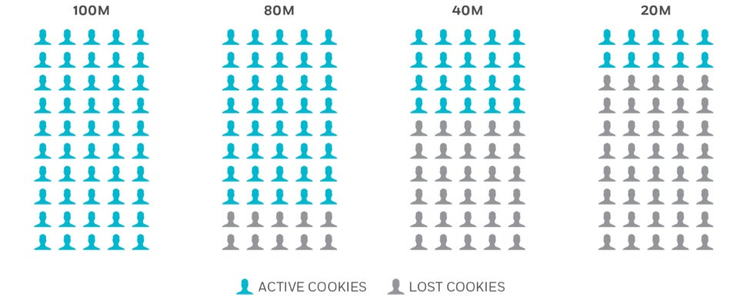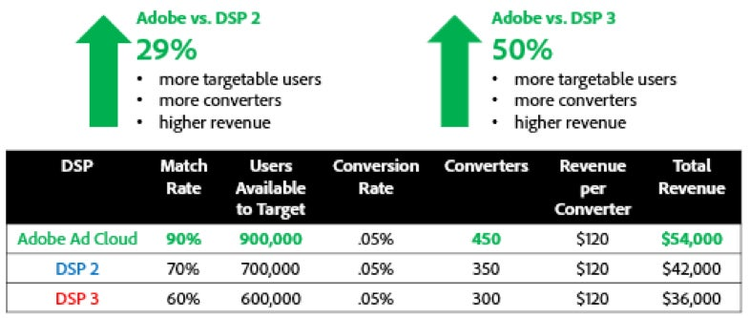Why Do Audience Match Rates Matter?

Why do match rates matter? Because audiences matter. Whether your business does offline direct marketing or online programmatic advertising, the ability to reach the right audience is fundamental to achieving your marketing goals.
In digital advertising, reaching a higher volume of a high-value audience gives an advertiser more opportunities — through leads, sales, and revenue — to drive performance. Nowadays, many online advertisers use a data-management platform to consolidate audience data — for instance, site visitors, offline customer relationship management (CRM), partners, and third-party demographics — and end up with robust, individual, anonymous user profiles they can use for audience segmentation and targeting across the web.
So, What Exactly Is a Match Rate?
The pursuit of data-targeting at scale has popularized the match-rate concept, which usually refers to the percentage of users that a demand-side platform (DSP) recognizes within a given audience segment. Data naturally leaks throughout the various stages in the activation progression — from data-onboarder to data-management platform (DMP) to demand-side platform (DSP) to inventory. In the activation process, lost profiles directly correlate to decreased match rates, reducing the targeted scale advertisers can achieve.
As the graphic below illustrates, four distinct data matches occur during the media-execution process:
Offline ‣‣ Online Onboarder;
Onboarder ‣‣ DMP;
DMP ‣‣ DSP; and
DSP ‣‣ Ad Exchange/Inventory.

Let’s look at match rates within the context of one of the more popular real-world use cases: retargeting site visitors — users who have demonstrated both high interest in an advertiser’s brand and intent through their actions while on the site (abandoning shopping carts, visiting specific product pages, etc.). Retargeting is an evergreen (or “always-on”) tactic for many advertisers because these audience segments are the low-hanging fruit that consistently drives performance. For most advertisers, these coveted, high-performing audience segments can never be too big or have too many members. Fortunately, advertisers can gain more from this limited group of high-value users by working with integrated data-management and media-buying platforms that deliver greater audience matches.
But, Do Match Rates Really Matter?
To illustrate why match rates matter, let’s look at an example of the impact for display advertising by comparing the reach of different DSPs within one DMP. Using our previous retargeting scenario, we’ll take a more simplified approach, assuming a frequency of one ad view and each DSP’s consistent synchronization of cookies with ad exchanges.
- The advertiser wants to reach their best-performing audience segment — shopping cart abandoners.
- One-million users in the DMP can be targeted.
- Advertiser pushes the retargeting segment to three DSPs, including the Adobe Advertising Cloud DSP.
- Three DSPs have three different audience sizes and match rates with the DMP segment (90 percent, 70 percent, and 60 percent).
- The result is a significant impact on the number of converters and the revenue.

Advertisers often work with many different technology platforms, and a common challenge they face is that sharing data and audiences across the different layers of their technology stack is often difficult — or even impossible. When building a stack, one of the primary considerations for marketers is whether the advertising layer is tightly integrated with the other platforms. Can data and audiences be shared easily across platforms? How high are the audience match rates? These are important questions that should be asked early in the planning phase — not after the ink has dried.
Can Adobe Advertising Cloud Help You Increase Audience Match Rates?
Adobe Advertising Cloud is the first independent end-to-end platform that unifies audience data, media execution, and creative personalization to enable full-funnel ad-buying and optimization — from lower-funnel performance tactics (e.g., search, display) to upper-funnel brand tactics (e.g., video, programmatic TV). Our focus is on achieving the highest audience match rates possible. We’ve been able to achieve match rates exceeding 90 percent for first-party audiences ported from Adobe Analytics Cloud into Adobe Advertising Cloud DSP.
And, what about the end viewer? Consumers demand relevant ad experiences. In a recent survey, 78 percent of respondents said they want relevant ad experiences, but only 28 percent feel they are actually receiving them. By reaching more high-value audiences, an advertiser can better personalize experiences across display, video, and other channels.